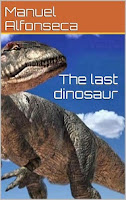Since genetic engineering began, in the last quarter of the 20th century, the idea arose of the possible recovery of extinct species. In 1990, Michael Crichton published his famous novel Jurassic Park, which is based on the practical realization of this idea to reconstruct various species of dinosaurs and set up with them a very special zoo. I talked about this novel in this previous post, and in this one.
The procedure used in Crichton's novel is
unworkable. First of all, we do not have the DNA of any species of dinosaur.
According to the novel, scientists would have obtained it by analyzing the
stomach contents of blood-sucking insects from the Mesozoic era that had been
preserved in amber. It is true that some scientists claimed that they had
obtained DNA from insects trapped in amber 80 million years ago, but according
to a 2013
study, it is impossible to obtain DNA from those insects if the amber is 60
or more years old, because it deteriorates very quickly. According to the
authors of the work, the DNA obtained by previous researchers must come from
the contamination of the samples by modern insects.
On the other hand, the dinosaur DNA supposedly discovered by Jurassic Park scientists is injected into the nucleus of a crocodile egg cell, which Crichton assumed would be close enough to dinosaurs for the cell to be compatible with its DNA. But this is not true: although crocodiles are the closest living reptiles to dinosaurs, they are as far removed from them genetically as hedgehogs, moles and shrews are from us, if not more so. The operation would not be successful.
Before begin celebrating the possibility
of recovering some extinct species, we must take into account the following:
- Most
of the ancient DNA that has been recovered is mitochondrial DNA, which is contained
inside the organelles that help our cells breathe oxygen. This DNA is much
more abundant than the nuclear DNA, because in each cell there are many
mitochondria and a single nucleus, but the DNA regulating the development
and reproduction of eukaryotic cells is the nuclear, not the
mitochondrial, so the nuclear DNA should be used to try to recover some
extinct species. It is true that in a few cases (for instance, from
the droppings of non-arboreal sloths and in
the case of the dodo) nuclear DNA has been obtained, but the complete
genome is rarely known.
- If
insects enclosed in amber have been disappointing, in very cold
environments the DNA can last longer. Currently, the oldest animal from
which DNA has been obtained is a
Siberian mammoth from more than a million years ago.
- The
development of a multicellular being does not depend only on its DNA,
which acts as a "hard disk", but on epigenetic
inheritance, which is the program that uses nuclear DNA data (and
other additional data not yet well known) for a living being to develop
properly. Even if we had the complete nuclear DNA, which rarely happens in
the case of extinct species, some of the information would be missing, as
well as the development program, which is not exactly the same from one
species to another.
There has been talk of using genetic
engineering to fill in the genomes of recently extinct species with genes from
closely related species, and then growing that genome by inserting it into eggs
of that closely related species. But recent
studies seem to indicate that what would be obtained in this case would not
be the resurrection of the extinct species, but rather a hybrid between the two
species used. If this process were applied to the mammoth, it would not be a
mammoth, but a hybrid of elephant and mammoth: a hairy elephant.
Among the extinct species that are often mentioned in the context of their possible recovery are the mammoth; the dodó or dronte (Raphus cucullatus) from Mauritius; the Tasmanian marsupial wolf or tiger (Thylacinus cynocephalus); the New Zealand moas (Dinornitidae), exterminated by man about 500 years ago; and the passenger pigeon (Ectopistes migratorius), decimated by excessive hunting during the 19th century, which had been the most abundant bird in the United States and disappeared completely in 1914. The oldest is the mammoth; the others have become extinct during the last millennium.
In short: it is not enough to know the
complete nuclear DNA genome of an extinct living being to be able to recover
it. It is possible that in the future it will be achieved, but much remains to
be done. And recovering the dinosaurs will be very difficult.
Thematic thread on Primitive Life: Preceding Next
Manuel Alfonseca



No comments:
Post a Comment